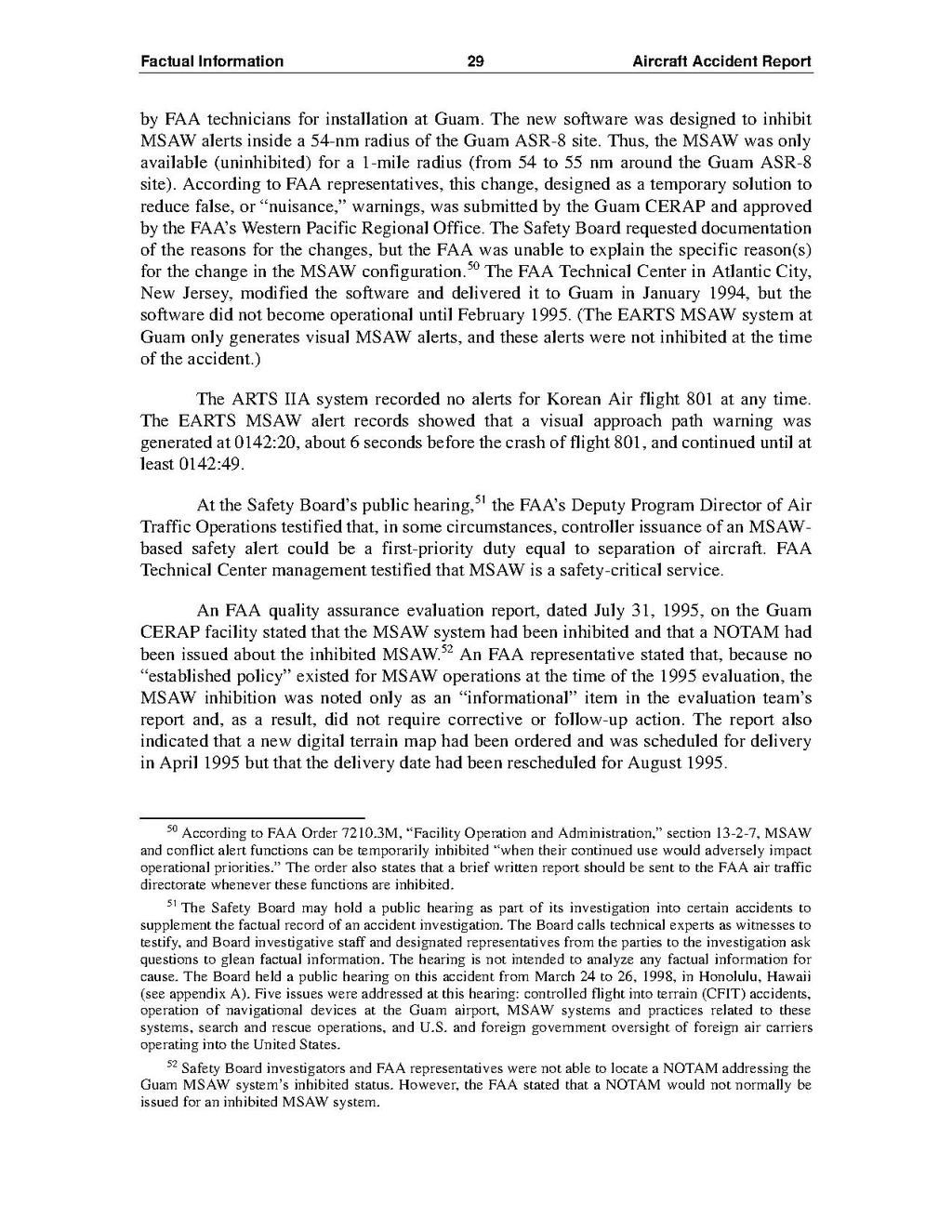by FAA technicians for installation at Guam. The new software was designed to inhibit MSAW alerts inside a 54-nm radius of the Guam ASR-8 site. Thus, the MSAW was only available (uninhibited) for a 1-mile radius (from 54 to 55 nm around the Guam ASR-8 site). According to FAA representatives, this change, designed as a temporary solution to reduce false, or "nuisance," warnings, was submitted by the Guam CERAP and approved by the FAA's Western Pacific Regional Office. The Safety Board requested documentation of the reasons for the changes, but the FAA was unable to explain the specific reason(s) for the change in the MSAW configuration.[1] The FAA Technical Center in Atlantic City, New Jersey, modified the software and delivered it to Guam in January 1994, but the software did not become operational until February 1995. (The EARTS MSAW system at Guam only generates visual MSAW alerts, and these alerts were not inhibited at the time of the accident.)
The ARTS IIA system recorded no alerts for Korean Air flight 801 at any time. The EARTS MSAW alert records showed that a visual approach path warning was generated at 0142:20, about 6 seconds before the crash of flight 801, and continued until at least 0142:49.
At the Safety Board's public hearing,[2] the FAA's Deputy Program Director of Air Traffic Operations testified that, in some circumstances, controller issuance of an MSAWbased safety alert could be a first-priority duty equal to separation of aircraft. FAA Technical Center management testified that MSAW is a safety-critical service.
An FAA quality assurance evaluation report, dated July 31, 1995, on the Guam CERAP facility stated that the MSAW system had been inhibited and that a NOTAM had been issued about the inhibited MSAW.[3] An FAA representative stated that, because no "established policy" existed for MSAW operations at the time of the 1995 evaluation, the MSAW inhibition was noted only as an "informational" item in the evaluation team's report and, as a result, did not require corrective or follow-up action. The report also indicated that a new digital terrain map had been ordered and was scheduled for delivery in April 1995 but that the delivery date had been rescheduled for August 1995.
- ↑ According to FAA Order 7210.3M, "Facility Operation and Administration," section 13-2-7, MSAW and conflict alert functions can be temporarily inhibited "when their continued use would adversely impact operational priorities." The order also states that a brief written report should be sent to the FAA air traffic directorate whenever these functions are inhibited.
- ↑ The Safety Board may hold a public hearing as part of its investigation into certain accidents to supplement the factual record of an accident investigation. The Board calls technical experts as witnesses to testify, and Board investigative staff and designated representatives from the parties to the investigation ask questions to glean factual information. The hearing is not intended to analyze any factual information for cause. The Board held a public hearing on this accident from March 24 to 26, 1998, in Honolulu, Hawaii (see appendix A). Five issues were addressed at this hearing: controlled flight into terrain (CFIT) accidents, operation of navigational devices at the Guam airport, MSAW systems and practices related to these systems, search and rescue operations, and U.S. and foreign government oversight of foreign air carriers operating into the United States.
- ↑ Safety Board investigators and FAA representatives were not able to locate a NOTAM addressing the Guam MSAW system's inhibited status. However, the FAA stated that a NOTAM would not normally be issued for an inhibited MSAW system.
